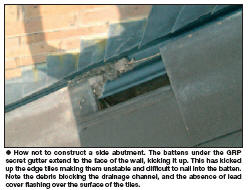 |
 |
 |
 |
 |
 |
 |
|
Check out our web directory of the UK
roofing and cladding industry
www.roofinfo.co.uk |
Sign up for our monthly news letter. |
|
|
|

Side abutments, where the left or right-hand edge of a roof meets a
vertical wall, look very similar to a verge, and in many ways they are.
But, for a watertight junction, the construction is very different.
If the side abutment is not at right angles to
the line of the battens then water running down the roof could either
run into, or away from, the side abutment; these are called raking
abutments and are outside of the scope of this article. Provided that
the side abutment is at right angles to the line of the battens then the
following comments will apply.Battens
In many instances the tile battens at a side abutment will finish
hard against the abutment wall. This is acceptable with profiled
interlocking tiles where a full cover flashing is used correctly, or
with proprietary abutment flashing units. But for all other situations a
secret gutter and cover flashing is the recognised best practice
solution. This will require each batten to finish 38 to 50mm away from
the abutment to allow the drainage channel in the lead or GRP secret
gutter, to be formed in the depth of the batten, against the abutment
wall. Provided the last rafter is located 50mm away from the abutment
wall, fixing the end of the batten will be easy, but if the rafter is
hard against the abutment wall an additional 50 by 50mm batten will need
to be fixed to the side of the last rafter to support the end of the
batten that stops 50mm short of the wall. With a lead secret gutter and
cover flashing detail the lead drainage channel will not support its own
weight and will need to be supported with a 50 by 50mm batten fixed down
between the wall and the last rafter and screwed into position.
Eaves
At the bottom of an abutment where a secret gutter is installed
there must be a clear path for any water in the secret gutter to drain
out into an eaves gutter. This can be achieved by finishing the underlay
support board and over fascia ventilation grill short of the abutment,
or to cut a notch in the fascia board, to allow the secret gutter
channel to run through and finish into the guttering. However there is a
potential clash with the underlay that will be installed below the GRP
secret gutter and have to rise up onto the top of the underlay support
tray. There is not an issue with a lead secret gutter as bitumen
underlay should not be laid under a lead flashing or gutter in the first
place. An alternative solution is to reduce the pitch of the secret
gutter channel approaching the eaves and install a lead fantail to allow
the water to flow over the fascia board into the gutter. Where the
bottom of a side abutment meets lower tiling a lead fantail is essential
to bring any water out onto the head of the lower tile.
Bond
When setting out the tiles the bond pattern of the tiles is an important
consideration. The tiles are likely to be either straight bond or half
bond (broken bond), but occasionally with a mock bond appearance the
true bond is achieved using a quarter or three quarter tile. Depending
upon which bond you have will depend on the module that you have to use
to finish at a side abutment with the minimum number of uncut tiles. The
traditional method of finishing on a whole tile is to shunt the tiles in
or out along the row. There are always occasions when it is impossible
to finish on a whole tile and therefore tiles will need to be cut to
fit. With any piece of tile that is smaller than half the width of the
original tile there is a risk that fixing the small section of tile will
be difficult, especially if a secret gutter is being used.
Fixings
A continuous lead cover flashing is in effect a continuous clip that
helps to hold down the edge row of tiles, therefore if the fixing
specification requires the edge tiles to be clipped, the lead will
suffice on a left hand abutment.
|
 |
|
Where all perimeter tiles are required to be mechanically fixed using
nails there may be a problem achieving the nail fixing for a flat cut, or
half tile, as the nib is often cut off to prevent it clashing with the
secret gutter and the nail hole coincides with the secret gutter material,
or misses the end of the batten. In these
instances it is better to finish the side abutment 20 to 40mm away from
the side abutment and extend the lead cover flashing over the top
surface of the tile to achieve the required minimum side lap cover. The
side lap dimension is not measured from the face of the wall but from
the edge of the tiles.
Flashings
With interlocking tiles, soakers must never be used. Therefore a lead
cover flashing will be required. With flat interlocking tiles the
minimum side lap distance should be 150mm. However with profiled
interlocking tiles side lap cover is not so easy to determine. Many
profiled interlocking tiles have a trough that is flush with the side
interlock, such that unless the flashing goes over a full roll water
creeping in between the flashing and the tiles will run onto the trough
of the tile and could run off the edge. The recommendation of the Lead
Sheet Association is that the flashing covers a full roll. Depending
upon the location of the roll at the side abutment will determine the
actual side lap cover distance.
Tiles like a single pantile can present a
problem as the bulk of the profile is a trough and the nail hole is
situated at the bottom of the trough. Therefore to cover a complete roll
requires one and a half tile width to be covered with flashing or the
edge tile to finish as a cut half tile, making it impossible to nail fix
into position. Provided the rafter pitch is steep, finishing the
flashing in the trough of the first tile appears to be adequate but will
only have a cover of 110mm rather than the minimum 150mm. However at
rafter pitches close to the minimum pitch for the tiles water leakage
problems will occur. As a rule of thumb rafter pitches less than 45¡ã
should have the wider flashing, but there is no definitive ruling or
test data for this.
Soffit
At the head of a side abutment there is often a diminishing space
where the side abutment meets a soffit. This space is often left
unfinished and can allow birds to enter the roof and nest. Where the
roof and the soffit meet it is impossible to nail the top tile and
almost impossible to install a flashing. In these instances it is better
to install a vertical board on a timber framing between the soffit and
the tiling, to allow the top tile to be installed correctly and a lead
flashing to dress down over the head of the top course of tiles. While
this may form an additional section of side abutment between the soffit
and the base of a valley, it is better than leaving it open for birds
nest in the roof.
Tips
- Where possible the tiles should be set
out to finish at an abutment with a whole tile.
- Soakers should never be used at a side
abutment with interlocking tiles.
- The end tiles at a side abutment
should be set so that they do not kick up and the nail fixings do
not puncture the secret gutter.
- The construction of the top and bottom
of a side abutment are as important as the middle.
|
| Compiled by Chris Thomas, The Tiled
Roofing Consultancy, 2 Ridlands Grove, Limpsfield Chart, Oxted, Surrey,
RH8 0ST, tel 01883 724774 |
|